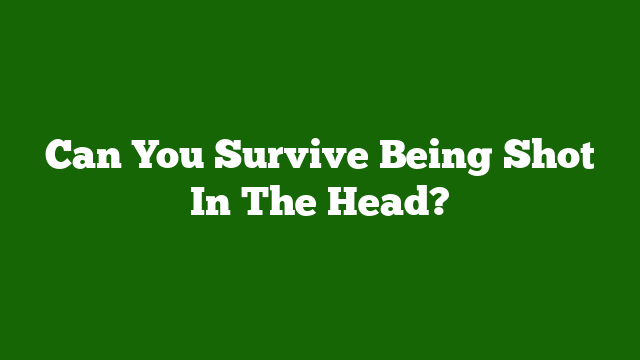Last Updated on June 12, 2023 by Umar
Surviving a gunshot wound to the head may seem like an impossible feat, but research and personal stories show that it is not always a death sentence.
In this comprehensive blog post, we will explore the factors that impact survival, share personal stories of those who have survived, and delve into the research and statistics surrounding gunshot wounds to the head.
Survival Rates and Factors
According to a study conducted at Yale, civilians with gunshot wounds to the head or other penetrating brain injuries have a 42% chance of surviving.
However, the U.S. Centers for Disease Control and Prevention estimates that 90% of brain injuries resulting from firearms are fatal, with only 10% of survivors living with persistent disabilities.Several factors can impact the chances of survival, including:
- Motor control of limbs
- Pupil response
- Lower overall trauma score
- Age
- Gender (women tend to fare better than men)
- Transfer from another hospital
The bullet’s trajectory and velocity also play a significant role in determining the severity of the injury
. For example, patients who are shot from the front to the back of the head often have a better chance of survival than those shot from side to side.
Personal Stories of Survival
One of the most well-known cases of surviving a gunshot wound to the head is that of Congresswoman Gabrielle Giffords.
In 2011, Giffords was shot in the head during an assassination attempt in Arizona.
She survived the attack and has since undergone extensive rehabilitation
.Another survivor, Phineas Gage, was a railroad construction foreman who survived an iron rod penetrating his skull in 1848.
Although he experienced significant personality changes, Gage was able to return to work and lived for another 12 years after the accident.
Research and Statistics
Research on gunshot wounds to the head has revealed some interesting findings.
For example, a study published in the journal Neurology found that those with self-inflicted wounds had a worse prognosis, and women tended to do better than men
. Additionally, a Glasgow Coma Scale score of 3 to 8 was associated with a higher mortality rate.According to 2018 data, the highest incidence of gunshot head wounds was related to assault (49.2%), followed by suicide/self-inflicted (41.9%) . The mortality rate for assaultive gunshot wounds to the head was 41%, increasing to 74% for isolated head wounds compared to 52% for non-isolated wounds.
Conclusion
Surviving a gunshot wound to the head is not guaranteed, but it is not impossible either.
Factors such as the bullet’s trajectory, velocity, and the victim’s overall health can influence the chances of survival.
Personal stories of survival, along with research and statistics, provide hope and insight into the complexities of gunshot wounds to the head.
Helpful Resources
- https://medicine.yale.edu/news-article/gunshot-wound-to-the-head-not-a-death-sentence-1/
- https://medicalxpress.com/news/2011-01-bullet-surviving-shot-host.html
- https://codmansurgical.integralife.com/gunshot-head-wounds-what-impacts-survival/
- https://www.medicinenet.com/surviving_a_gunshot_wound_to_the_head/views.htm
- https://www.baltimoresun.com/health/bal-te.brain05oct05-story.html

